![]()
The Words of the Allen Family
|
|
The Words of the Allen Family |
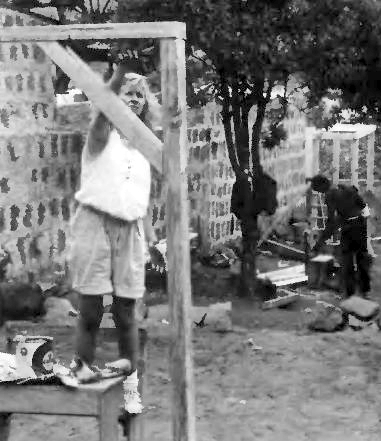
Building
a children's playground at the Santiago site
This summer on June 30th, students from various campuses in the United States met in Guatemala for a special event: the third annual World Student Service Corps international project. This year's group was also comprised of students from Mexico, Honduras, the Dominican Republic, Japan, Korea, the Philippines, Canada, West Germany, and of course, Guatemala. The WSSC was initiated and founded in 1986 by Hyo Jin Moon, World CARP president. Inspired by the ideal of service, students participating in the Third World CARP convention in New York were seeking an active, concrete way to express their idealism. The WSSC was born and has since conducted programs on both the local and international levels.
Once again under the directorship of Gary Page, this year's Central American program began with a one-day orientation at the Pan American Hotel in Guatemala City. For the past two years the Pan American has provided a simple yet beautifully typical and very warm environment to welcome students into the fascinating culture of Guatemala. Participants were introduced to this year's staff, led by Gaetan Dutil, the on-site project coordinator, as well as Fritz and Anna Schneider, the two missionaries in Guatemala who gave invaluable assistance. Also they were briefed on the history of the WSSC and its activities, and made aware of health and safety precautions. Right from the first day, students were given a chance to test their abilities to bargain at the Central Marketplace or to see Guatemala City.
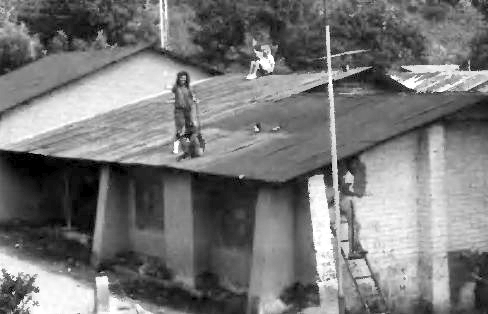
Painting
the school in San Pedro
The orientation program ended with a buffet dinner for participants and friends from past years, as well as a marimba concert given by Congressman Baudillo Ordonez. Congressman Ordonez amazed us all by his being the only man in Guatemala able to play marimba with six sticks all by himself. Normally it is played by four or five men at a time. He is also one of the foremost authorities on the diverse indigenous cultures of his people. Everyone present enjoyed his performance, including the Guatemalans.
On the morning of Sunday, July 2, the group began the three hour journey that would take them from Guatemala City through the breathtaking highlands to Lake Atitlan, which Guatemalans proudly claim as the most beautiful lake in the world. With three towering volcanos eternally guarding its lush green flora and clear blue waters, I would have to agree. We boarded the Santa Maria, the boat that would take us from Panajachel across the waters of Atitlan to San Pedro. Until only four or five months ago Panajachel was the only village out of twelve on the lake with a telephone; now a few villages have one phone each. Boat travel is almost the only means of transportation on or around Lake Atitlan due to the lack of roads.
At the shores of San Pedro we were welcomed by old friends we made from past projects and new friends we would soon make. We settled into our residence, which would be our home for the upcoming month. The beds were lumpy, the rooms a little crowded with two or three sharing a small room, and the one shower per fifteen people had cold water only; but most hadn't expected more. We were still living better than many locals who have no running water or electricity. The rooms were clean, however, and the hotel staff treated us like family so we quickly adapted to our new environment. Our first evening in San Pedro was made memorable by a local marimba band that came to welcome us to their town. It seemed as if there wasn't a shy person in the group this year as most began dancing as soon as the music started and begged for more when the band had to leave. The indigenous people looked amused watching foreigners dance to local tunes, but only a few were brave enough to join in with us.
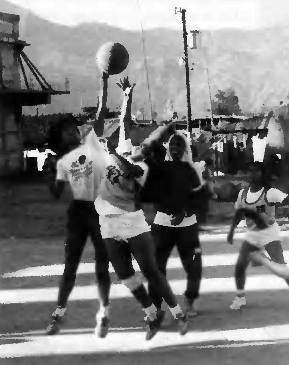
WSSC
girls challenge the local team
After the welcome celebration all were ready to get down to some serious work, of which there was plenty. There were five projects that awaited us. In San Pedro, where we were staying, major additions were done to the central school. A total of approximately 1,000 students were benefited from our work. Doors and windows were put in where there previously were none in six major classrooms. The rooms were painted, a ceiling installed, and new floors were added. A second project in San Pedro was the painting, inside and out, of another small village school. This second project was enthusiastically led by Denise Mast, a recent Ohio State graduate and second time participant of WSSC.
In Santiago Atitlan, the largest village on the lake, there were three projects. One was located at the two-story community center we had constructed over the last two summers. A small rotating group of students added finishing touches to its already beautiful structure. Upon arrival at the second site in Santiago, I had absolutely no hope that we could accomplish what we were planning, and I was supposed to lead this group! We were to add a classroom and playground to the two-room schoolhouse WSSC participants built last year. All I saw was a jungle, thick with green trees, plants, and huge boulders everywhere. After the first day, when all the trees were cleared by one man and his young son with their trusty machetes, I began to have hope. I must admit I had no idea just how industrious these people are.
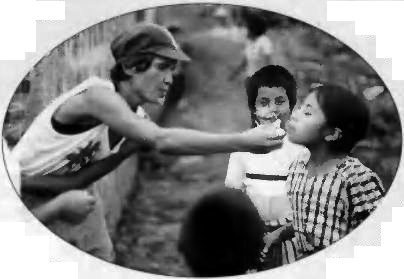
This summer, each participant learned intimately the meaning of hard work, carrying water, bricks, cement, and all the materials for the school and playground on their backs. For us it was a new and somewhat novel experience, but for the locals it is their daily life. It isn't unusual to see a man carry even up to 300 pounds on his back. What is even more shocking is to find out that these same people make sometimes the equivalent of only two to three dollars for a whole day's hard labor. Needless to say, poverty took on an entirely new meaning.
It was truly a beautiful sight to see progress day by day as large boulders II were cracked apart and removed piece by piece, or as giant tree stumps were patiently axed out bit by bit. The walls of the schoolroom grew and the playground slowly appeared. The most inspiring part was the unity created between the hired indigenous workers and the students. Both caught the spirit underlying this effort to serve others, and both were determined to bring the project to a finish in the short time allowed. Although there were three or four languages being spoken on the site it was amazing how harmoniously the work went. Everyone managed to communicate quite effectively, sometimes even without words.
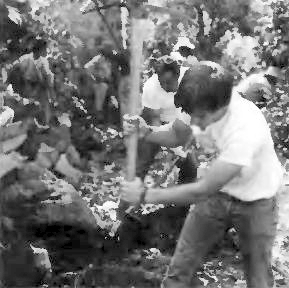
There were numerous other activities, some planned and some impromptu, that made this summer's experience particularly enriching. A local woman gave weaving lessons in her two-room home, while some took time to have a lesson in Tsutufil, the local dialect. A few took a day to go horseback riding. Melanie, a medical student, traveled for a day with a local doctor. Some went out on the lake on a cayuco, a dug-out canoe, and a large group took a one day trek up the volcano of San Pedro to see sights they never imagined possible. As has become a tradition, local basketball teams challenged WSSC teams. This year, for the first time, we won two games out of four!
A special weekend trip was planned to Chichicastenango, a beautifully colorful Indian village about two hours ride from San Pedro. Students had the opportunity to experience market day, a day when people come from near and far to sell their wares. Adventure seemed to be waiting around every corner in Chichi as there were hundreds of vendors with countless beautiful objects to sell, often at unbelievably cheap prices. Of particular interest to many was the main Catholic Church in town. One could observe the mixture of Catholicism with ancient Mayan rites, as Indians burned fires on the steps, swung incense, made offerings of plants, flowers, candles, and swayed, chanting their prayers in native tongues. The one incident from our weekend trip that stands out in my mind happened over dinner. We had invited two indigenous friends from San Pedro to join us for the weekend, neither of whom had ever left their villages before. As we awaited our meal I noticed one of them looked a little uncomfortable, so I asked him if he was okay. He said, "I have never gone away from my family before, so I am homesick." Here he was 25 years old and missing his family after only six hours! I realized we had something important about family ties to learn from these people.
This year we were again fortunate to have Dr. Seuk, President of WSSC, come to review all the work that had been accomplished and to address the Closing Banquet. He came with Gary Page, our executive director, who returned for the closing proceedings with his wife, Gloria, who had been assisting the project throughout. They traveled throughout the lake to different sites, guided by Gaetan Dutil, and accompanied by the Guatemalan advisors Juan Carlos Villatoro and Francisco Gonzales. Dr. Seuk also took the opportunity to bargain with a local indigenous vendor for a Guatemalan shirt, which he proudly wore during the day.
In the past two years we have been able to meet with the President of Guatemala, Vinicio Cerezo, but unfortunately due to prolonged strikes and arbitration taking place he was unable to meet with us. He did send us his best regards through his representative, the Minister of Foreign Relations, who graciously met Dr. Seuk and our group. The President also sent a close aide, the Secretary to the Vice President, to our Closing Banquet, who gave a short and inspiring speech to participants thanking us for our work in his country.
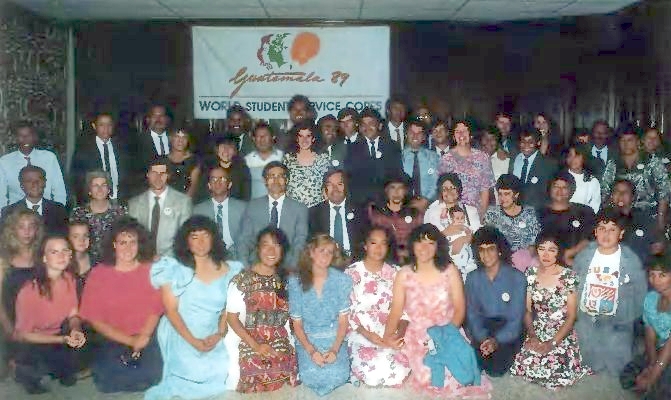
Group
photo at the Closing Banquet
Probably the most fulfilling moment for all was to see the various projects come to fruition. On each site all the work had been accomplished as was planned and this left participants and workers alike with a feeling of satisfaction and pride.
Knowing that 70 children will no longer sit on rocks in their one-room bamboo schoolhouse, but have a three-room concrete building with wooden desks and a steel roof to keep the rain out in the rainy season, and knowing that we built it with our own hands is an incredibly gratifying feeling. Upon seeing all the ecstatic children rush in joyfully to play in their new playground I had to suppress tears several times. How we take so much for granted in developed nations! Through this whole experience our lives had been changed in many ways. Most realized, unexpectedly, they had received far more than they had given.
When the work was done and it was time to leave San Pedro, this year there wasn't a dry eye to be found. I honestly felt a part of my heart had been implanted in this beautiful village and would stay with these people forever. Needless to say it was a painful good-bye. Just because we were educated and most of the people there were illiterate, just because we had money and they didn't, just because we shared no common language, just because we were different races, religions, and were from different cultures and parts of the world -- these things didn't matter at all. We could love each other. As our boat pulled out for the last time and we waved good-bye to all our friends, I realized the simple truth Father has been speaking about for years: love breaks down all barriers. We had truly experienced this first-hand. I was reminded of the thirteenth chapter of First Corinthians, "... if I have all knowledge and all faith so as to remove mountains but have not love, I am nothing. If I give all I have to the poor, and if I deliver my body to be burned but have not love, I gain nothing. So faith, hope, love abide, these three, but the greatest of these is love."